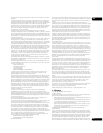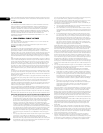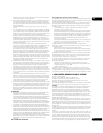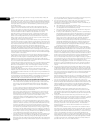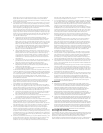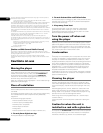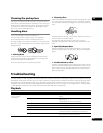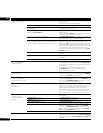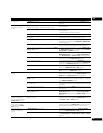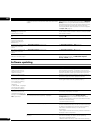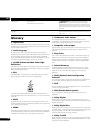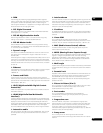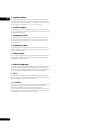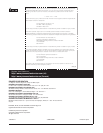
71
En
07
DRM
A technology for protecting copyrighted digital data. Digitized
videos, images and audio retain the same quality even when they
are copied or transferred repeatedly. DRM is a technology for
restricting the distribution or playback of such digital data without
the authorization of the copyright holder.
DTS Digital Surround
DTS Digital Surround is an audio format to record 48 kHz/24 bits
audio signals in 5.1 channels.
DTS-HD High Resolution Audio
DTS-HD High Resolution Audio is an audio format using lossy
coding. It can record 7.1 channels at 96 kHz/24 bits.
DTS-HD Master Audio
DTS-HD Master Audio is an audio format using lossless coding.
With BD-ROMs, 7.1 channels can be recorded at 96 kHz/24 bits, or
5.1 channels at 192 kHz/24 bits.
Dynamic range
This refers to the difference between the maximum and minimum
level of the sound. The dynamic range is measured in units of
decibels (dB).
When the dynamic range is compressed (Audio DRC), the minimum
signal level is increased and the maximum signal level decreased.
This way, the volume of loud sounds such as explosions is reduced,
while the sounds with a low level, such as human voices, are easier
to listen to.
Ethernet
A standard for local area networks (LANs) used to connect multiple
computers, etc. in the same location. This player supports
100BASE-TX.
Frames and fields
A frame is the unit for one of the still pictures which compose
motion pictures. One frame consists of a picture of odd lines and a
picture of even lines called fields in video signal with interlaced scan
method (480i, 1080i, etc.).
HDCP (High-bandwidth Digital Content
Protection)
HDCP is a specification to protect audiovisual content across the
DVI/HDMI interface.
HDMI (High-Definition Multimedia
Interface)
A digital interface standard for next-generation TVs expanding the
DVI (Digital Video Interface) terminal used for example for computer
displays. It allows transfer of non-compressed digital video and
audio signals (Dolby TrueHD, Dolby Digital Plus, Dolby Digital, DTS-
HD Master Audio, DTS-HD High Resolution Audio, DTS Digital
Surround, MPEG-2 AAC, linear PCM, etc.) with a single connector.
Interactive audio
The audio signals recorded in the titles of BD-ROMs. They include
for example the clicking sound made when the menu screen is
operated.
Interlaced scan
With this method, one picture is displayed by scanning it twice. The
odd lines are displayed in the first pass, the even lines are displayed
in the second, to form a single picture (frame). Interlaced scan is
indicated in this player and operating instructions by an “i” after the
resolution value (for example, 480i).
IP address
An address that identifies a computer or other device connected to
the Internet or local area network. It is represented a number in four
sections.
Linear PCM
This is referred as the audio signals that are not compressed,
frequently used for DVD-Video discs containing musicals or music
concerts. This can also be indicated “48 kHz/16 bit”, “96 kHz”, etc.
MAC (Media Access Control) address
A hardware identification number assigned specifically to the
network device (LAN card, etc.).
MPEG (Moving Picture Experts Group)
The name of a family of standards used to encode video and audio
signals in a digital compressed format. The video encoding
standards include MPEG-1 Video, MPEG-2 Video, MPEG-4 Visual,
MPEG-4 AVC, etc. The audio encoding standards include MPEG-1
Audio, MPEG-2 Audio, MPEG-2 AAC, etc.
Multi angle
Up to 9 camera angles can be recorded simultaneously on BD-ROM
or DVD-Video discs, letting you view the same scene from different
angles.
Parental Lock
Playback of the contents of some BD-ROM or DVD-Video discs can
be restricted, for example for discs containing scenes of violence.
With BD-ROM discs, an age restriction can be set to restrict
playback. Playing DVD-Video title can be restricted by setting the
parental lock level.
Picture-in-Picture (P-in-P)
This is a function for superimposing a sub video on the main video.
Some BD-ROMs include secondary video, which can be
superimposed on the primary video.
Port number
This is a sub-address provided below the IP address for
simultaneously connecting to multiple parties during Internet
communications.
Progressive scan
With this method, one picture is consisted of a single picture,
without dividing it in two pictures. Progressive scan provides clear
pictures with no flicker, in particular for still pictures that contain
much text, graphics, or horizontal lines. Progressive scan is
indicated in this player and operating instructions by a “p” after the
resolution value (for example, 480p).
Proxy server
This is a relay server for ensuring fast access and safe
communications when connecting to the Internet from an internal
network.



